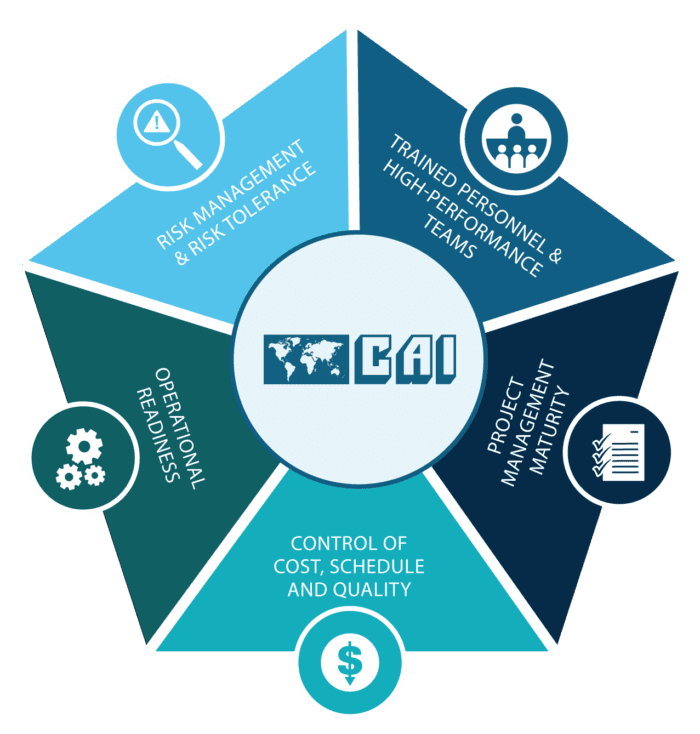
Turning Project Risks into Successes when Building an ATMP Facility

Need for Speed is the name of the game when building a facility to manufacture ATMP products. With a heavy focus on an accelerated schedule and getting your product to market faster this brings unique risks. Converting some project risk factors into success factors could change your whole dynamic and lead to an effective facility start up. First, there does not need to be a trade-off between cost, schedule, and quality, if your team understands how to deliver quality, right the first time. We’ll discuss 5 factors which can mark the difference between success and failure of your ATMP project.
Risk Management and Risk Tolerance
Managing risk is essential to any project success, particularly an AMTP start up. When you can manage risk, it keeps people safe and allows you to deliver a quality product which keeps your project on time and on budget. If you don’t actively manage risk within your project, your risk recognition will be haphazard and decisions on acceptable levels of risk are left to the individual. When this happens, typically you will see a major increase in deviations or re-work rates. Also, mishaps occur at a much greater frequency. When these issues mount, your project timeline starts to slip, cost overruns occur, and injuries ensue. Clear communication of the team’s agreed-upon standard for risk tolerance fosters alignment, ensures risk is managed appropriately, and enables work to proceed efficiently.
Some high-level risks involved in an ATMP project include:
- Adoption of innovative technology
- Tech transfer and scaling into a new facility
- Team formation and team building
- Attaining key schedule milestones are essential for rapid progressing of the products through clinical and into commercial production
Solution to risk management and tolerance is to place risk management at the center of everything you do. Implementing continuous and deliberate processes to assess and manage risk throughout your whole project lifecycle. You must continually identify risks, assess risk, mitigate the risk, and retire the risk as your project progresses. Risks and risk management activities need to be communicated throughout your project team to confirm alignment and reinforce the team’s standards for risk tolerance. Employ proven tools and methods such as risk assessments and risk registers, toolbox talks, safety walks, team communication, and other methods to continuously identify, assess, manage, mitigate, and retire risk. As the project execution and subordinate plans are developed, develop a project risk register to be incorporated into the project execution plan. This risk register will identify the major project risks and risk mitigation tactics. Develop a risk assessment that focuses on quality risks and helps with your process control strategy.
Trained Personnel & High-Performance Teams
Building an operations team for a new facility is always challenging. Finding the perfect talent with the right team dynamic is hard to come by these days. When hiring, don’t just look for technical skills but also identifying someone who is innovative, confident, and adaptable in fast-changing business environments. Also, selecting individuals based on their resume without analyzing for team dynamics brings risk to your project and team culture. If your carefully select and hire for skill set and team dynamic, with that will come a common mindset of integrity, high performance, and trusted team members who make the team more than just a group of qualified individuals.
Another solution could be supplementing this carefully selected core team with expert resources that provide the right skill set and culture mix dramatically reducing the project risk.
Project Management Maturity
An ATMPs project, like any project, consists of a scope, deliverables, budget, and schedule. These all need to be managed within your quality system. Having robust project controls consisting of defined metrics, reporting, project procedures for safety, quality, and task accomplishment all enable project success. Failure to practice good project management is the main contributor to a failed project. Having an experienced project management partner helps achieve rapid project management maturity in several ways. They can provide experienced leaders and technical experts allowing you to focus on other areas that are more important for facility startup. With your PM partner you can work with site level leadership, planners and schedulers, and other stakeholders to integrate their processes into your site program management processes. Finally, your PM partner should recommend and implement best practices and tools that help the whole team deliver successfully.
Control of Cost, Schedule, and Quality
Project controls go hand in hand with project management. Project controls provide regular monitoring of performance against established baseline schedules, budgets, and deliverables. These metrics provide for cost forecasting, planning for resource on-boarding or off-boarding, contingency planning when situations arise that impact schedule or cost, and regular status reporting. When you employ a robust methodology for project management that is governed by an internal quality management system you have an increase in performance and higher quality deliverables.
A focused team that thrives on achieving high performance and delivering the best quality product and the best value is key to a successful project. Maintaining the right resource plan ensures the right personnel are engaged at the right times and leads to a higher performing team. The right scope definition and control forms a basis for budget, schedule, manning, and quality success.
Operational Readiness
Operational Readiness is the wholistic approach to achieving a facility and team that is fully capable of performing all aspects of cGMP manufacturing operations at the design throughput or run rate. There are many workstreams that go into achieving operational readiness. See the high-level diagram below.. The breadth and depth of tasks needed for a new facility to reach Operational Readiness are substantial. Often, companies underestimate the time and resources needed for these essential activities. In addition to resources and scheduling, experience in site start-up is essential to ensure on-time launch and maximum output.
Using a proven methodology to identify and implement is the most efficient path for the firm to achieve operational readiness and ultimately operational excellence. In our experience the proven methodology begins with an Operational Readiness Assessment. The Operational Readiness Assessment is a structured approach which assesses programs and workstreams that need to be in place to achieve the owner’s intended use for the site – and to establish a high-level roadmap for the project team to achieve to optimize and coordinate the workstreams. This roadmap is an immediate value to site leadership as it provides the basis for organizing, prioritizing, and allocating resources to rapidly make progress toward site objectives.
About the Author:
 Joe Micsko, Global Director, Process Manufacturing Technology (PMT), CAI
Joe Micsko, Global Director, Process Manufacturing Technology (PMT), CAI
Joe Micsko leads CAI’s Process Manufacturing Technology business area and is an Engineering SME. He oversees various projects for Biotech/Pharma clients. He has a wealth of knowledge and experience with over sixteen (16) years in the Pharma/Biotech Industry especially in Single Use Technology (SUT) and Cell and Gene Therapy (C>) Startups. Joseph manages the development and implementation of process improvements designed to achieve greater efficiency in overall Business Operations. He is a subject matter expert in CIP systems, Chemical Distribution Skids, Upstream and Downstream Processing, Single use systems, Autoclaves and Steam-in-Place (SIP). He has extensive knowledge of planning, coordinating, and executing Cleaning Validation Programs to verify compliance and absence of cross-contamination. Joseph has experience with Quality Risk Management (QRM) specifically in process risk and control strategies. He has successfully managed and led diverse teams across the globe delivering numerous Pharma/Biotech projects.



